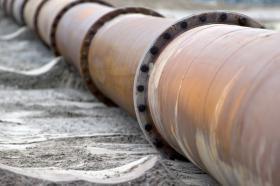Page 17
EPIB Trail
Volume 7, Issue 4
Utility of Natural Gas Questionable at Best By: Alexander Nayfeld
Development of sustainable infrastructure for energy transportation has been an increasingly important task for cities with growing populations. The dissemination of energy resources within high-density population centers, however, is proving to be a dilemma with regard not only to the costs and planning involved, but also with regard to the environmental impact of the necessary infrastructure. A team of researchers led by Kathryn McKain of Harvard University has released a study, which posits that there exists definitive proof that approximately three percent of the natural gas delivered to Boston leaks directly from the pipeline into the atmosphere. In fact, the correlation within Boston between miles of pipeline and leakages is, for all intents and purposes, considered linear by the Center for Energy and Environmental Studies; for every 50 miles of cast iron mains throughout Boston, there exist a consistent 300 leaks. The most pressing issue with this leakage is that the predominant natural gas leaking into the atmosphere is methane, a greenhouse gas which, molecule for molecule, has significantly more global warming potential than carbon dioxide: by a factor of approximately 72 times. This study is directly corroborated by a previous cooperative study conducted by Google and the Environmental Defense Fund, which utilized sensors to determine that Boston’s pipelines are critically aged, and were definitively not providing secure transport for natural gas. The issue here, however, is not solely that the leakage of methane into the atmosphere is harmful as a result of climate change impacts, but that the usage of natural greenhouse gases to fuel our energy requirements is likely itself a significant problem. This goes hand in hand with EPA affiliated researchers’ claims that the environmental costs of natural gas are undersold by potentially 75%. Increased popularity in natural gas consumption as a source of “clean” energy has spurred a wide array of construction of pipeline infrastructure for the exclusive transport of said gases. If we look at the inefficient nature of transportation of said gases within Boston as a microcosm, picturing the collective pipeline infrastructure of America alone becomes very frightening. The picture, which materializes, then is essentially a poorly contained system of free-flowing, potent greenhouse gases which has spread across the entire continental United States and beyond. If even half of the national system is as poorly maintained and as inefficient as Boston’s unique pipelines, the outlook for America’s climate change prospects are grim to say the least. With enough methane to fuel 200,000 homes year-round being dissipated into the atmosphere on an annual basis within Boston alone, it may become increasingly important to evaluate the benefits of natural gas sources of energy with a grain of salt. Further, all across the state of Massachusetts, the immediate ecological effects of leaky natural gas pipelines have been incredibly prominent. Belowground pipelines, which had been leaking methane for extended periods of time, actually are directly responsible for the dying off of trees in many areas. The methane leaking out of these pipelines actually deprives trees of oxygen at the roots, causing trees to, essentially, suffocate. In addition, many of these trees are public shade trees, and with many of these trees taking between 60 and 80 years to become fully grown, and costing near $100,000 each, the negative externalities of these gas pipelines are truly becoming gargantuan over time. All concerns of the consequences of natural gas pipelines, real or potential, ought to be well evaluated in the future calculus of how energy transportation infrastructure will be developed. Fortunately, the mass majority of natural gas leakage problems are centered at a few select areas, making it relatively simple to target the worst transgressors of natural gas pipeline inefficiencies and eradicate the problem at the source. As a collective society, which is constantly intent on pursuing new ways to fuel itself, we need to also understand the fatal error in blindly setting up media to deliver these fuel alternatives to all population centers of the world. A methane leakage rate of three percent is nothing to dismiss lightly, especially when this leakage is derived from a pipeline, which serves to fuel one of the largest metropolitan centers in the world. It is time we become weary of our methods of energy consumption and begin critically analyzing the implications of all facets involved in that consumption. Without this mindfulness, it is almost a certainty that humanity’s effect on the climate will become increasingly catastrophic as our dependency on energy grows upwards. Sources: http://www.enn.com/pollution/article/48230 http://www.enn.com/top_stories/article/6253 http://www.enn.com/top_stories/article/47068 http://www.sciencedirect.com/science/article/pii/S0269749112004800#
Back to Index

















